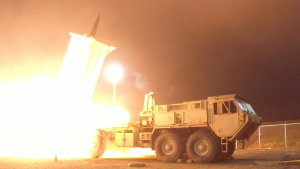
On July 30, 2017, the Missile Defense Agency (MDA) announced it conducted a successful test of the Terminal High Altitude Area Defense (THAAD) system. The test came in the wake of another successful test of THAAD held just weeks before, and after reports that the South Korean government will proceed with further deployment of the system in the South. All of this positive news must be tempered with a realistic assessment of THAAD’s capabilities.
THAAD is designed to defend against short, medium, and intermediate-range missiles by intercepting them as they fall towards their targets. A radar system tracks incoming missiles and a control unit coordinates the launch of interceptor missiles from truck-based launchers. The interceptor missiles then slam into incoming missiles, destroying them without explosives in what is called a hit-to-kill intercept. According to a Department of Defense release, THAAD is being deployed on the Korean Peninsula, “to ensure the security of South Korea and protect alliance forces from North Korea’s weapons of mass destruction and ballistic missile threats.”
The MDA claims THAAD has performed successfully in all of its last 15 tests. In its most recent test, the system tracked and intercepted a medium-range ballistic missile over Alaska. However, as the Center’s Senior Science Fellow Philip Coyle noted, the system has never been independently tested against more than two incoming missiles, putting in doubt the ability of the system to perform against a barrage of incoming missiles.
That isn’t the only flaw in the system. THAAD’s radar has a 120-degree field of view. That’s enough to cover South Korea, but the system would be blind to a missile launched from a submarine outside of THAAD’s view; a capability North Korea is reportedly developing. The radar is also limited in the amount of objects it can continuously track. Analysis by Michael Elleman and Michael J. Zagurek concluded that a limited barrage of 20 ballistic missiles could be enough to saturate THAAD’s radar. Missiles fired at highly lofted trajectories, which would reenter the atmosphere at higher velocities and steeper angles, could also pose major problems for the system.
Currently, only one THAAD battery, composed of six launchers carrying eight interceptor missiles each, is approved for deployment in South Korea. North Korea is estimated to possess 1,000 ballistic missiles. THAAD would only be a viable defense in the case of a limited attack by North Korea with missiles that fall within THAAD’s range.
While successful tests are further demonstrations of THAAD’s capability against limited short and medium-range ballistic missile attacks, there are clear reasons to doubt the system’s capability to defend against realistic attacks. Further, THAAD should not be oversold as a solution to potential long-range missile threats from North Korea, as the system lacks any proven capability to defend against intercontinental ballistic missiles. THAAD treats the symptom of a problem, not the cause. To lower tensions on the Korean Peninsula, the United States must engage diplomatically with North Korea.
~ Kevin Kramer, Center for Arms Control and Non-Proliferation Intern
